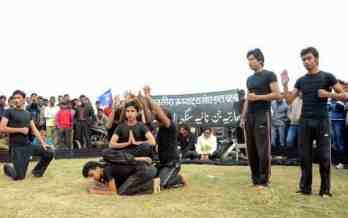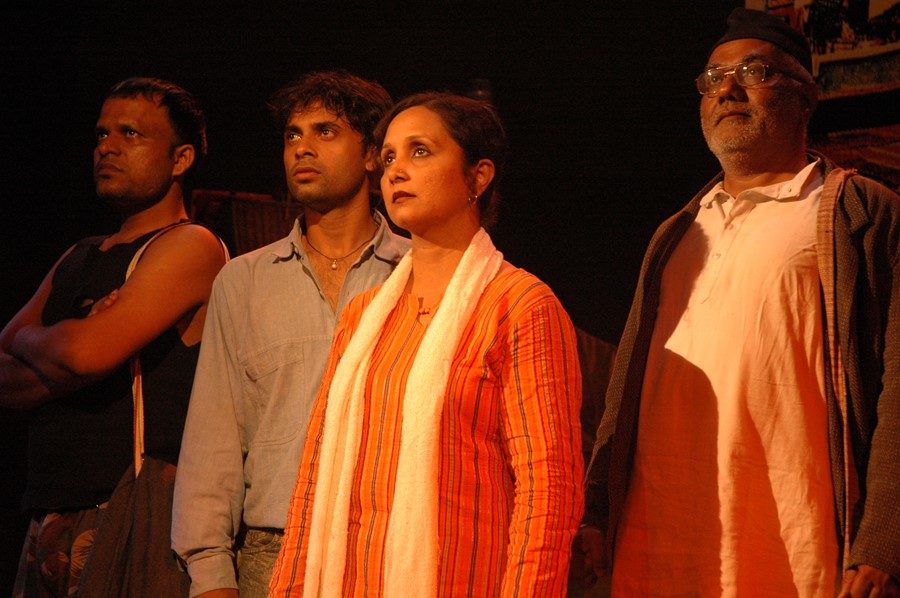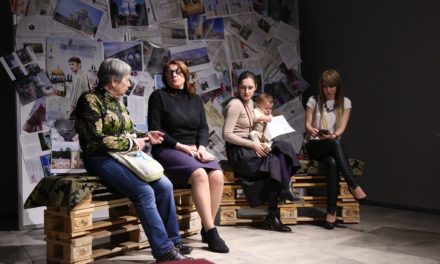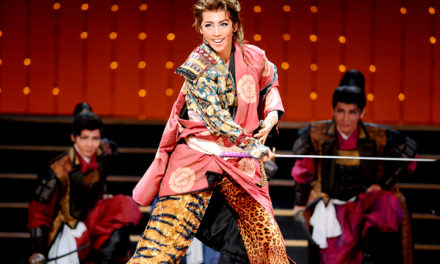Impact of Street-Theatre on the Formation of Indian Feminist Theatre
The introduction of feminist theatre or women theatre in India has a quite long but hidden history. Indian women’s entry into cultural arts has been pioneered by Devadasi, prostitutes, and tawaifis in various places. Indian women have had a longtime connection with regional language-based theatre from late-nineteenth century. By mingling the European dramatic art with that of indigenous performance tradition, they popularized the Folk theatre, Street theatre, Rural theatre, Dalit theatre, Amateur theatre, Professional theatre, and Regional dances which ultimately turns into an organized performative version under the eclectic umbrella of ongoing feminist movements. Therefore, to formulate aesthetics of Indian feminist theatre is much more dependable on how the theatre historians or scholars evaluate regional theatres of provinces. In terms of theatrical practices, Indian states like Bengal, Maharashtra, Punjab, Gujarat, Tamil Nadu, and Kerala occupy immense significance in the cultural map. All these states more or less took initiatives to educate their womenfolk by using their cultural stage and in this respect, theatre acts as the best medium to rewrite or revisit its own cultural history. The gradual development of these vernacular theatres culminates into a distinctive gender specific genre: the Indian feminist theatre. Though the pre and post-independence occasions dominates the stage in terms of sociology, polity, and culture, but the chief goal of this pan-Indian theatre is to raise feminist consciousness across the country regardless of caste, class, and community. The aims and objectives of this theatre is to relocate the lost drama/theatre tradition of female and also encourage new generation women playwrights to reinstate the female in a prestigious socio-cultural position.
Though the initial attempt for ameliorating the women condition in socio-cultural field has been placed by theatre movements of IPTA, but gradually the agenda seems to gear towards the national interest and as a consequence of it, women’s issues in the domestic sphere remains overlooked. But after a brief hiatus, this oversight has been redressed through the efforts of a number of groups who take interest to raise critical awareness about women agenda and their struggles to public attention through street theatre. The newborn consciousness of feminist presence and women question increasingly claims a particular stage or medium to access the public. The feminist drama in India takes its origin from street-play and folk theatre. The Marxist movement of the 1930s is the springboard for founding the radical Indian theatre like Indian People’s Theatre Association (IPTA). The folk theatre like Jatra, Bhavai, Nautanki from different states had an intense impact upon the mass regardless of class and caste. The experimental of folk and street theatre remains appealing for both civic performers and their audiences due to its reformative aspects. Political turmoil during pre/post-colonial period has been interpreted and enacted through these mobile media like street plays. The performance of street plays collects the cultural matrix from the heritage of folklore and mingles them with the contemporary political phenomenon to arouse socio-politic consciousness, mobilize communities, and constitutes identities. The grassroots level feminist groups organize to protest against political exploitation of women related events through dramatization. In her epilogue on women’s street theatre, Nandi Bhatia argues that, as women’s images were resolutely patriarchal in each of the earlier periods she discusses, women’s street theatre in post-independence India has begun tackling previously unexamined issues of domesticity, abuse, and sexuality. (Bose 3). The feminist group like Sahiya of Baroda presents the documentary Women In Search Of Their History composed by Vibhuti Patel and IPTA performs the pieces like Aaj Ki Sawaal, Charge Sheet, Bhook Ki Jwaala, and Swathantra Sangram to introduce the feminist agendas to society. Each of these plays has different aims to bolster the feminist argument for conceptualizing the rhetorical analysis of feminist and performance theory in Indian context. The regular practice of street plays galvanize the Indian notions of aesthetics and arts with that of concurrent socio-political issues which may construct an Indian feminist constituency enriched with traditional folk literature and also may reveal the female association with its rich convention.
The major achievement of organizing street plays by grassroots feminist groups is to put emphasis on the fact of absentia of common women and the exclusion of them from Indian historical narratives. In lieu of the elite class, high caste Hindu virangana type women, the street plays attempt to project the common women as belonging to the tribal, Dalit and other marginalized strata of society. By representing their quotidian experiences, its mission was to display these common women’s struggle for democratic rights, ecological preservation, and a violence-free public-private sphere where they can get the socioeconomic security for healthy living. These performances help them to understand their potential agency in ushering long-lasting social change. A common social experience of marginality, exclusion, and oppression brought them together to enact a women’s culture within their respective communities. Indian feminist scholar, Garlough thinks that while reinterpreting and connecting fragments of oral history, memory, and folk tradition, the rendition of street theatre hopes to reconceive common practices as revolutionary, heroic, and ultimately potentially constitutive of an Indian feminist consciousness. Thus, despite the diversity of uniqueness of experiences, aesthetics of Indian feminism make up a feminist constituency on the basis of shared oppression.
At the point of art and identification, Abhinavagupta observes that “true” aesthetics experience of art can only be possible when the audience can identify himself with the dramatic persona of the stage. The artistic identification between audience and performer could be exchanged through the successful transmutation of emotions and ideas. This orientation of self-reflexivity and identification is a very prominent feature of street theatre which attracts the feminist movements to spread its revolutionary doctrines against social evils caused by imperialism. Feminist scholar and activist Malini Bhattacharya has argued that street play performance
“provide an important means by which audiences come to know themselves, others and the social problems facing their communities” (Garlough 121).
The intimacy made between audience and performers helps to eliminate the “fourth wall” or aesthetic distance which creates a new dramaturgical dynamics that has a close affinity with the feminist sense of “personal is political.” The vibrant improvisation because of industrialization and urbanization of culture has made huge popularity of street theatre. The assemblage of diverse people in any public places like courtyards, factory gates, religious shrines, halls, and even on open air to observe the performance is a great advantage of street theatre. It doesn’t have any roof rather it eradicates the predefined structure of theatre building which increases the close proximity of interaction of the audience to the performers.
Moving away from conventional theatre practices, scholars examine the ways in which social organizations use theatre to contribute to larger changes in society. While theatrical space is being reworked to accommodate revisions of nation and gender history, structural principles of theatre are also being modified to make it a more flexible mode of representation. Street theatre, for instance, emerges as one such approach to performance that takes theatre beyond the proscenium as a tool of awareness and protest. Theatre activists and women’s organizations adopt this form of theatre to reach out to people in their own familiar spheres of everyday life, creating a greater sense of dialogue and community between the viewers and performers. Theatre practitioners like Mangai emphasize the interventionist rather than the didactic role of theatre while addressing issues such as dowry murders and female infanticide. As a step towards a conscious assertion of their “subject status,” Mangai proposes theatre activities that require greater improvization and participation on the part of women spectators. According to Bhatia,
“For many women, participation in street theatre provides the impetus for turning their domestic identities or limited roles into new independent social identities.” (118).
Under the camouflage of entertainment, street theatre severs as a concrete medium to do some social change. The use of dialogue, song, dance in street theatre performance always offers scope for mass discussion about social problems and also helps to march together to make solutions for it. While doing so, such kind of performance automatically involves people into transformation politics through its strategically design methods of social critiquing and consciousness raising. To exemplify this salient feature we may take the example of Vibhuti Patel’s Women In Search Of Their History which has been dramatized by the Baroda group Sahiyar. Being a part of the autonomous women’s movement, this group primarily works for women’s right. It also arranges political campaigns to sensitize about the women-related topics like rape, domestic violence, communal violence, amniocentesis, abortion, etc. Their feminist approach of sharing personal experiences is valuable for social reformation. Actually, Patel in her writing emphasizes on participating in consciousness raising campaign for finding feminist recognition. She believes that women’s collective endeavor definitely brings social transformation. In her discussion, street-plays work like “travelling texts” that exists within the matrices of multiple opportunities for participation in different context and time. And for promoting Indian feminism, sharing experiences is like storytelling method which is an effective tool to reach out to uninitiated people in the women’s movement. Her writing provides a new lens to interpret women’s history from a feminist perspective. In her argument street theatre generally supports the feminist agenda to propagate among the community. The major achievement of this play is that it deals with five separate issues of paramount importance to the feminist movement in India: consumer and environmental economics, rape, property rights, sati, and domestic violence.
Patel’s documentary also highlights upon the gaze manifested through the performance of street theatre. The point of seeing and being seeing is very prominent in street theatre as eye contact between audience and performers is happened frequently. The surrounding landscape, venue, or gathering public is also relevant for exchanging the gaze. Sometimes this gaze fueled a desire to identify the performers and their feminist agenda. On the point of “gaze,” Garlough comments:
“the sense of gaze also worked productively to connect the actors together, creating a sense of ‘we-ness’ that transcended their personal histories. Interestingly, the performance also facilitated a critique of the ‘male gaze’ which women often are asked to manage in their everyday lives. The performers on stage directly addressed the audience…challenging the ‘pornographic gaze’ and ‘panoptic discipline’ of the female body. Also, ‘there was a sense of seeing and being seen after the performance concluded–a way of seeing and being seen as feminist continuing to enact a political role in the public sphere.’ (Garlough 178).
The Indian street theatre generally advocates the politicization of performance along with its performers’ engagement with contemporary social issues. There is a close socio-psychological affinity between audience and performers due to their personal experiences and political convictions which have drawn them to play. Without any knowledge about the issue, these women audience or performers enact a testimonial, illustrating realities that they experience. The truth of women’s suffering and oppression have brought them together. This unknown closeness and engagement of common experience of suffering tie them in singularity and provides an ethical relationship of recognition. This sense of singularity and recognition enthuse many young girls and working women to join the women’s movement. While the street theatre of Baroda searches the lost history of women, the same performing tool in North India attempts to focus on the spatial politics of the public-private sphere in women’s lives. In the northern academic map, the geopolitics situation chiefly deploys theatre as a vehicle to raise the consciousness of people against domestic violence. In this regard, the rise of people’s theatre, more particularly women’s theatre carries the responsibility to promote an alternative vision of development in which their struggle for equal rights in politics and economic empowerment would be materialized. While politicizing the violence in women’s lives and highlighting the rage with which Indian women have claimed theatre as a space to rearticulate their relationships with public and private.
Unlike Vibhuti Patel, Richa Nagar stresses upon the fact of women’s violence, matrimonial institution, and system of patriarchy in her analysis of street play for promoting feminist agenda among common people. In her study of street play’s involvement in grassroots feminism, she talks about of how the female body and its resistance encrypts into a fight to keep the body alive. The evaluation of female body in the politics of cultural difference has been put in stake for systemic social emancipation. Nagar highlights the body and its performance as an oppositional and collective form of socio-political action. The body functions as a performative site upon which multiple social identities are continually encoded and decoded. The body as an operative system exposes the dynamics of power and exploitation. Thus, when the stage turns into a body which transformed into a sign, it denotes multiple meanings. By utilizing the body as a sign of protest, the street theatre can make possible to alert the people about their political, social and economic marginalization and prerogatives. The ways of protests against most horrible forms of violence have been made by street theatre that it subverts and redefines the notions of public and private in the context of feminist politics.
Nagar’s observation of Matinee Show, an unscripted version of Oldenburg’s study about the courtesans of Lucknow articulates again the feminist politics of public and private: more precisely personal is political. The rendition is a satire about the matrimonial institution and related bourgeois notions of respectability and morality. This show actually helps to internalize the meaning of woman to tawaifs. Through their enactment, they try to express the demarcations (if any) of their “khoti” lives and a housewife’s “homely” lives. Through it, an alternative ideology of respectability has been launched for promoting womanhood among so called “kotha” women to maintain their own social and professional milieu. Their performance highlights the hollowness of heterosexual normative dominance by maintaining the social hierarchies. It is also a sarcastic reflection upon the lingering existence of power relations. The Lucknow courtesan women use this performance as a means of resistance in reversing or inverting the patriarchal structures in order to reproduce their own practice.
Another examination on Vanangana’s street theatre campaign that advocates against domestic violence in Chitrakoot area also features of how the venom of domestic violence intricate the lives of women and try to paralyze their empowerment. Activists of this organization focus upon women literacy, access of legal rights, share stories of violence and their intervention in dowry deaths of nearby villages which ultimately creates a political understanding in women. The grassroots workers are chiefly “women-only” group who promote activities against domestic abuse by conducting feminist street theatre in order to reshape the agenda of the organization. Their performance of the play Mujhe Jawab Do! conceptualize the notion of how public-private turns into spatialized and politicized through a campaign. It deals with the domestic issues of kinship, marriage, and women’s exploitation in marital family. Generally, their attempt is to highlight the fact that criminal indulgence of dowry murder involves the family, the kinsman, and the community: no one escapes the responsibility of a daughter’s death. The bride price is nothing but a commodification of women. The socio-spatial strategy of natal and conjugal family in occurring of dowry death implies women’s lack of access to resources and their devaluation inside the household and their subordination also.
Jana Natya Manch’s production of Aurat (Woman)! celebrates the multitasking role of women. The play subverts the elitist notions of womanhood and articulates the explicit political connections of gender, class, and sexuality within a home and outside with target of a revolutionary change. The projection of street plays Aurat and Hulla Bol creates so vital impact on mass, that it terrorizes the ruling party. As a consequence, the assassination of Safdar Hashmi (1989) contaminates the Indian cultural history. Hashmi with his sharp thoughts sacrificed his life at the altar of Indian culture. The play Aurat narrates the troubles of labour politics in terms of production, reproduction and revolution. Another street play Who Bol Uthi (literally, She Rose To Speak) by Jana Natya Manch deals with a little girl who refuses to be coed down despite the family’s favoring the male child; the dutiful middle-class women prevents her daughter being married off to corrupt official; a factory worker insists on a separate toilet for women–being added to the Union’s demands.
The practice of street theatre in India outlines the fundamental framework of feminism as well as feminist theatre. Performance of street theatre talks about the essential requirements of women lives which are ignored by traditional male theatre. Feminist issues like domestic violence, rape, dowry death, female feticide and sex determination have been well scrutinized and criticized through street performance. The grassroots feminist activists of India also access this medium to reach out to common people. The performance of street theatre on topics of contemporary women-related issues helps the Indian feminists to not only clarify the meaning of feminism but also to shows urgent need for the construction of a separate woman-only theatre in Indian context. The selection of topics and methodology of performance in street theatre creates a close bonding between performers and audience that makes the spectators as a critic. Such kind of intellectual exchange psychology in audience-performance manipulates the women playwrights to introduce a new pattern of theatre through which female folk can raise their voice against their oppression, exploitation and subordination and also simultaneously found their agency for further empowerment.
The forming idea behind women-only theatre has partially owed to street theatre of India. The performance of street theatre overtly exposes the gender specific nature of theatrical representation which arouses a sensation among women performers that while a theatrical performance glorifies the male spectator as an active recognized identical personality; the same theatrical representation intends to depict women performers/spectators as passive, invisible and voiceless one. This differentiation creates a gradual rift between traditional theatre practitioners and women theatre practitioners which ultimately results in the introduction of feminist theatre in India. Actually, street theatre in India endows with the fundamental requirements agendas and methodology of feminist theatre. To exemplify this view, we may say that the requisition of minimal stage properties used by street theatre has been adopted by Indian women playwrights as they show their economy in choosing apparatus for stage decoration. Again, in using the language, women dramatists try to follow the tradition of street theatre where performers prefer to use colloquial, regional dialects enriched with bold but monosyllabic dialogue. Like street theatrical script, women playwrights also concentrate on current events and real-life cases as their dramatic subject which engages the feminist agendas of concurrent India. Unlike street theatre, feminist theatre must have a stage, but it follows the discussion mode as dramatic action at the so call stage also. Again, for the structural purpose, like street theatre, feminist theatre broadly follows the Brechtian formula in lieu of Aristotle. Thus, the rudimentary structure of Indian feminist theatre has been rooted into the convention of street theatre.

IPTA street play. Image credit: Bihar Info directory
The importance of street theatre as a motherboard of feminist theatre in India has been well argued by feminist activist cum theatre practitioner Malini Bhattacharya. The revitalization of street theatre has been popularized through the organized political theatre movement of IPTA (Indian People’s Theatre Association) in 1940. While Bhattacharya talks about the relevance of street theatre that its target is not “only to provide entertainment, but to serve as a cultural intervention that can work directly at the level of people’s consciousness” (Nagar 59). She highlights the socio-political and cultural implications of street theatre in order to schematize the feminist theatre of India. It is an available medium for Indian women to politicize their struggles. In brief, it may be said that women’s organizations throughout the country have recognized and adopted street plays as a powerful but dynamic medium of communication for criticizing prevailing norms. It helps them to voice forth an alternative vision and also mobilize their audiences around issues such as dowry, domestic violence, women’s education, and marriage. Thus the politicization of cultural realm along with emerging feminist concerns has been come into notice through street performance which gradually turns into a distinct genre of feminist theatre.
References:
Abraham, Taisha. (Ed.). Feminist Theory and Modern Drama, Delhi: Pencraft International, 1998. Print.
Bhatia, Nandi. Performing Women/ Performing Womanhood: Theatre, Politics and Dissent in North India, New Delhi: Oxford University Press, 2010. Print.
Mangai, A. Acting Up: Gender and Theatre in India 1979 Onwards, New Delhil: LeftWord, 2015. Print.
Nagar, Richa. “Women’s Theater and the Redefinitions of Public, Private, and Politics in North India.” ACME, p.55-72. Web.
Richmond, Farley P., Swann, Darius L. & Zarrilli, Phillip B. (ed). Indian Theatre: Traditions of Performance (Vol.1), Delhi: Motilal Banarasidass Publishers Pvt. Ltd., 1990. Print.
Srampickal, Jacob. Voice to the Voiceless: The Power of People’s Theatre in India. London: Hurst & Company, 1994.
This article originally appeared on Muse India in the Mar-Apr 2018 edition and has been reposted with permission.
This post was written by the author in their personal capacity.The opinions expressed in this article are the author’s own and do not reflect the view of The Theatre Times, their staff or collaborators.
This post was written by Praggnaparamita Biswas.
The views expressed here belong to the author and do not necessarily reflect our views and opinions.


















